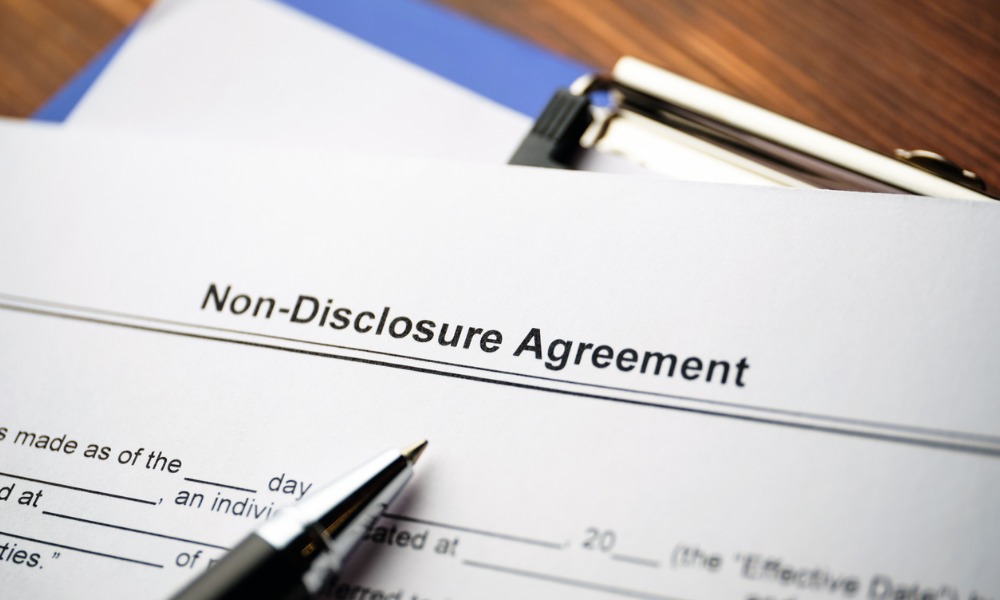

Every company has some confidential information that it must protect to ensure its profits. It can be anywhere from a simple marketing list or a food/product recipe to complex technological designs.
For this purpose, employee non-disclosure agreements or NDAs are frequently required by most employers. But what does Canadian law say about employee NDAs? Are they even legal in Canada? And can employees get away with it even if they signed an employee NDA?
Questions like these and much more are answered in this article. This is for employees and employers who want to learn more about NDAs. Lawyers can also use this article to educate clients (employees and employers alike) on the importance and consequences of an employee NDA.



An employee NDA, also called a confidentiality agreement, is a legally binding agreement or contract. It prohibits a person from disclosing another person’s sensitive or confidential information to third parties.
In the field of labour and employment, an employee NDA prevents a former or current employee from divulging the employer’s:
An employee NDA can be a clause in an employment contract signed by the employer and employee at the start of employment.
It may also be a separate document agreed by parties during an employer-employee relationship.
In either case, there’s no hard rule on the specific form that NDAs in Canada should conform with.
There are two types of NDAs:
NDAs can also be a part of a settlement agreement. This is to prevent victims from speaking publicly against the offending party, in exchange for the settlement. (There has been a recent campaign against the misuse of NDAs in this area.)
Watch this video to learn more about an employee NDA, its different types, and how it can be used by employers to protect confidential information:
Head over to our Special Report on the Top Labour and Employment Law Boutiques for a list of specialists who can help advise on employee NDAs.
The validity and enforceability of employee NDAs are governed by the different Canadian federal statutes.
This is in addition to common law and the Québec Civil Code covering topics related to contracts and agreements.
Here are some of the laws that cover employee NDAs in Canada:
Watch this video to know more about trade secrets, which are the usual subject matter of employee NDAs, and other ways to protect them:
Employers require an employee NDA to prevent employees from disclosing their precious trade secrets and confidential information to competitors and third parties.
For continued security, employee NDAs do not only cover current employees but also those who have left the company. Former employees are still under an employee NDA if it says so, or if it extends up to a certain period after the employment has ended.
Employee NDAs are legal in Canada. This is rooted in the Canadian courts and common law upholding the validity of employee NDAs.
For it to be a legally binding contract or agreement, or to become enforceable between the consenting parties, there are certain conditions that it must meet:
First, it must clearly state who are the parties involved in the NDA. Both parties’ names must be indicated, including their designations or other identifying characteristics.
In other words, it must state:
Third parties may also be described in the employee NDA. It may include names of people who can receive confidential information, without the receiving party possibly violating the employee NDA.
These third parties may be:
Next, the employee NDA must clearly define the confidential information that should not be disclosed or divulged to the public or to third parties by the receiving party.
While it may define information that the receiving party must not disclose, it may also define a specific piece of information.
It also states whether oral or written (or both) forms of communicating the protected information constitutes a breach of the employee NDA.
It is also helpful that employers or companies know what their intellectual properties (IPs) are, and how to protect IPs from infringement or theft.
Canadian IP laws are there to define what these IPs are, the ways that they can be infringed, and the penalties for such acts.
When drafting employee NDAs, it may also be helpful to refer to these Canadian IP laws, including Canada’s Criminal Code, when defining the IPs that are included.
The employee NDA must also define what confidential information is outside the scope of the agreement or contract.
This is important to help the employee or the disclosing party in determining what information must be protected, whether during or after employment.
Employee NDAs must specify what the employee can or cannot do in terms of preserving the subject sensitive information.
This part of the employee NDA also answers the question “what must the employee do to prevent violating the NDA?”.
Usually, an employee NDA will state that the employee must not disclose the information to the public or any third parties. It will then oblige the employee to take appropriate actions to protect the information or data.
In addition, the employee NDA may also state that the employee must not use the information themselves.
This is to prevent former employees from using the sensitive or confidential data they received against the disclosing party in favor of a third party.
Aside from stating specific confidential information excluded from the scope of the employee NDA, it must also specify exceptions. Some examples:
In these cases, the disclosing party may freely disclose the information without violating the employee NDA.
Also called the term or period of the employee NDA, the period of enforceability must also be clearly stated. While an employee NDA is always in force during the employer-employee relationship, what happens after its termination must also be specified.
This term may run from two to five years, or even up to 10 years. This is counted from the time the receiving party left the company.
It will also depend on other factors, such as:
This period may be different or the same as the period of the non-compete clause/agreement. In either situation, the term or period must still be specified in the contract.
One of the most important considerations in drafting an employee NDA is to include the penalties when breached.
It may include damages (e.g. liquidated damages) or the possibility for litigation and other forms of damages.
It may also be noted in the employee NDA that the sanctions are in addition (or without prejudice) to the penalties that may be imposed by other Canadian laws (e.g. IP laws).
Since an employee NDA is contractual in nature, its term depends on the agreement and the consent of both parties.
This means that, while the period is initially offered by the employer (as the one who usually prepares the NDA), the employee may still negotiate against it or leave the offer.
Since NDAs do not last forever, the most reasonable term or period must be considered, in consideration of the factors mentioned above.
Just like any other contracts, an employee NDA is a legally binding document. As such, breaking an NDA would have adverse legal consequences against the employee.
First, the NDA’s terms and conditions on violations will apply. Every employee NDA would have its own terms if it’s violated, and each would differ on these terms’ gravity.
Next, and in relation to the employee NDA’s terms and conditions, is a possible lawsuit against the former employee.
This lawsuit may also include an injunction. This is to restrict the former employee from continuing the acts that are violating the NDA.
It may also include damages against the former employee. These damages may include:
There are circumstances when an employee NDA may be “legally violated” by a former or current employee, such as the following:
In these circumstances, the NDA becomes unenforceable. This means that the current or former employee will not be penalized for “violating” the NDA.
Prince Edward Island (PEI) passed a recent law that limits the use of NDAs in specific cases.
Bill No. 118, or the Non-disclosure Agreements Act, was passed by PEI on November 16, 2021, and received royal assent on November 17, 2021. It came into force on May 17, 2022.
This recent law restricts the use of NDAs in a settlement agreement in cases of harassment or sexual misconduct. Here, the NDA can be part of the settlement only if the victim wants it to be included in the agreement.
These types of laws are also emerging in the other provinces to protect survivors of harassment and sexual misconduct. It also protects the public because they will now know that these persons or entities are perpetrators of these crimes.
For more articles on concerns related to employee-employer relationships, save and bookmark our Practice Area page on Labour and Employment.
The Canadian Legal Newswire is a FREE newsletter that keeps you up to date on news and analysis about the Canadian legal scene. A separate InHouse Edition is delivered on a regular basis, providing targeted news and information of interest to in-house counsel.
Please enter your email address below to subscribe.